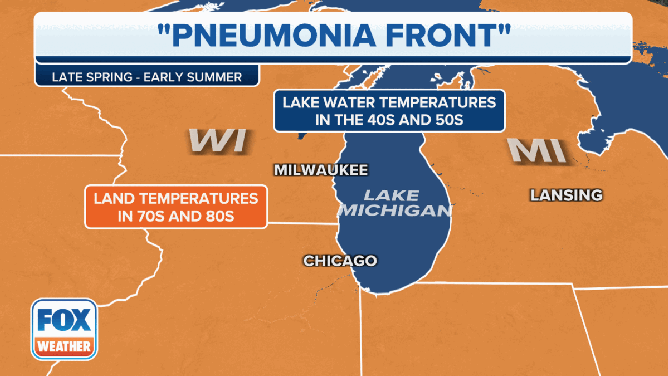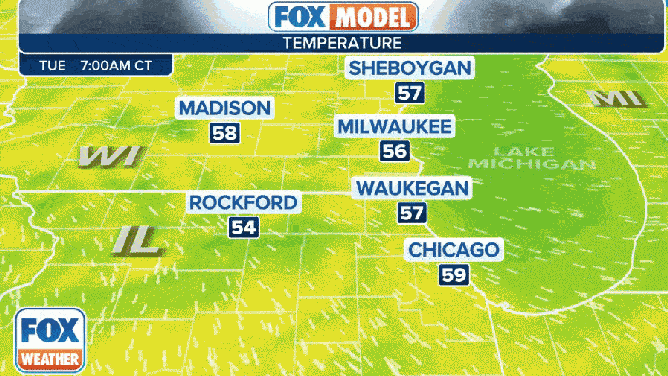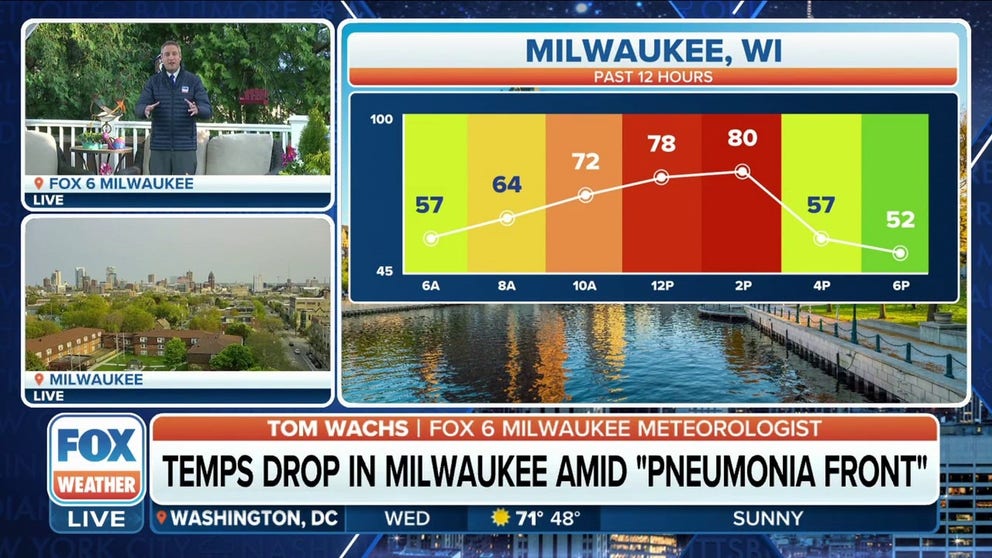'Pneumonia front' blasts Chicago, Milwaukee, plunging temperatures by 20-plus degrees in minutes
Temperatures dropped 24 degrees in just one hour in Milwaukee, sending the temperature of 81 degrees at 3 p.m. to just 57 degrees at 4 p.m.
'Pneumonia front' impacts Wisconsin: Temps plunge 20-plus degrees in Milwaukee in less than one hour
FOX 6 Milwaukee Meteorologist Tom Wachs said temperatures dropped 24 degrees in just one hour in Milwaukee, Wisconsin on Tuesday due to a backdoor cold front.
CHICAGO – A rapid drop in temperature happened Tuesday in Chicago and Milwaukee as a "pneumonia front" raced down Lake Michigan, changing a summerlike day to one more typical of the beginning of April in a matter of minutes.
Despite the name, you will not catch pneumonia from this type of cold front. The name simply refers to the dramatic temperature plunge for cities along the western shores of Lake Michigan as the front charges south through the lake's chilly waters, pushing that lake-chilled air into eastern portions of Illinois and Wisconsin.
What causes a pneumonia front?

The passage of a "pneumonia front" causes a rapid temperature drop as chilly air from Lake Michigan pushes inland.
(FOX Weather)
The current water temperatures in Lake Michigan are generally in the upper 40s and lower 50s. Temperatures Tuesday in Chicago and Milwaukee climbed to 80 degrees – but not for long… Temperatures dropped 24 degrees in just one hour in Milwaukee, sending the temperature of 81 degrees at 3 p.m. to just 57 degrees at 4 p.m.
"The bigger short-term headline is obviously the backdoor lake-enhanced cold front that will result in a rapid drop in temps this afternoon," meteorologists with the National Weather Service office in Chicago wrote in a forecast discussion Tuesday morning. "Gusty north-northeast winds are expected behind the front, especially close to the lake, where winds could gust to around 30 mph behind the front."
WHAT IS A BACKDOOR COLD FRONT?

A "pneumonia front" will cause temperatures to drop rapidly in portions of Illinois and Wisconsin on Tuesday, May 16, 2023.
(FOX Weather)
The strong difference in density and pressure between the warmer air mass ahead of the cold front and the cooler air mass behind it causes these so-called pneumonia fronts to progress rapidly southward down the lake and shoreline areas, according to the NWS Chicago. Warm air is less dense than cold air, which causes it to rise and allows the colder, denser air to replace it at the surface as the front moves in.
Pneumonia fronts are common in the Great Lakes during the spring when water temperatures are still cold after reaching seasonal lows in the winter.
CAN BIG TEMPERATURE SWINGS MAKE YOU SICK?
An extreme case occurred on March 24, 2017, when the temperature in Chicago dropped 29 degrees in one hour, falling from 77 at 5:15 p.m. to 48 at 6:15 p.m. That came up just 1 degree shy of Chicago's most extreme temperature drop of 30 degrees in one hour set on March 26, 1908, when temperatures fell from 71 to 41 between 2 p.m. and 3 p.m.
According to a 2005 study by Cory Behnke from the University of Wisconsin-Milwaukee, a pneumonia front – a term first used in the 1960s by the NWS office in Milwaukee – specifically refers to at least a 16-degree temperature drop in one hour, particularly along the western shores of Lake Michigan.
